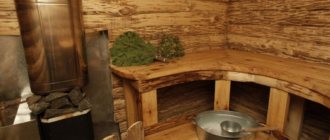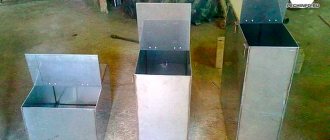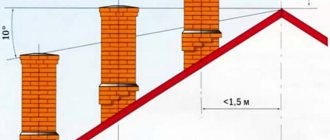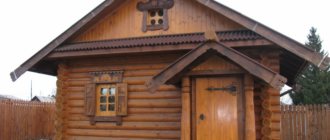Bathhouse and water are inseparable: water is needed for different purposes: watering stones in the stove, preparing brooms, washing after going to the steam room. Of course, taking a dip in cool water is healthier, but warm water in a bathhouse is a necessity.
Most often, a bathhouse is built in a country house, where there is no way to get hot water through a water supply. Cold water can be heated in a boiler or using a stove with a tank.
You can buy a ready-made oven with a container or purchase a tank separately.
How to choose a tank for a bath
The wide selection of different heating equipment has had little impact on the demand for conventional wooden tanks. Such products are environmentally friendly, light in weight, and have a wonderful aroma of wood, which makes the atmosphere in the steam room special. An additional advantage of such a capacity is resource saving, since the use of electricity or gas requires some costs. The constant presence of liquid in the room increases air humidity, which has a positive effect on the local microclimate.
It is especially important when purchasing a container to correctly calculate its volume. To do this, it is worth considering that each person spends on average about 25 liters of water per visit. Thus, for the needs of two people, a tank of 50 liters will be required. If you plan to go to the sauna with a large group, then it is better to equip the steam room with a spacious 100-liter tank.
Bath tank Source dekoriko.ru
Keys to choosing a hot tub
If you want to install a contrast tank in your bathhouse, answer a few questions that the sellers will ask.
1. How many people should fit: a question of tank dimensions and volume. The font with a diameter of 1.5 m can accommodate 4-6 people. If there are two people washing and steaming, you will end up wasting water and electricity.
2. Where it will be installed: outdoor or indoor - they have different characteristics. If options are available, communications will be required. Outdoor ones can be dimensionless, internal ones - the area of the sauna is taken into account.
3. Installation option:
- free-standing, ready for use immediately;
- built-in is just a bowl that requires a deepening (pit), installation, cladding, but gives a chance for a creative approach.
4. Shape: round, oval, corner, rectangular. Non-standard is possible - in the style of modern design. A vertical (standing or sitting) compact barrel will look awkward on the lawn of a spacious area. A large oval one, taking up half the space, will also not please you, complicating the bathing process.
5. Material: here consider quality, usefulness, price tag, durability (you may not need it for a hundred years, inexpensive enough for a short time).
- wood: warm, environmentally friendly, healing effect;
- plastic: does not rot, does not collapse, you can choose shapes, sizes, easy to clean;
- composite: ideal for outdoor use, super durable.
6. Bowl coating:
- without coating: a special smell, wood substances dissolve in water, making it medicinal. Require special care. Not recommended for outdoor use.
- waterproof coating: easy to care for the container, no wood smell and no healing effect, strong due to glued rivets. Installation is possible even in an apartment.
7. Rim mount:
- hoops with a screw connection: fine adjustment, the ability to tighten to ensure tightness, used on traditional glueless models;
- rivets: fixed tension, suitable for varnished products, plastic.
8. Water heating, frequency of use:
if used frequently, it is better to use an electric heater; high degrees are not required here. a wood heater indoors will require smoke venting, possibly remodeling
Pay attention - built-in or attached oven (each option has its own advantages and disadvantages). Outside, a live fire and the pleasant warmth of the stove create additional relaxation and relaxation.
a gas heater is the most economical, but not every bathhouse has the conditions for safe installation. These questions need to be thought through in advance.
9. Additional equipment:
- aero-hydromassage systems;
- thermal insulation;
- water filtration and disinfection systems;
- different types of water heaters;
- backlight;
- touch control.
These points are not the most important when making an initial decision, but it is better to take them into account in advance. Over time, there will be a desire to improve something, to retrofit it, but everything is installed in such a way that you can’t get under it.
Types of containers
There is a wide range of products for storing hot and cold water on sale. A large number of models allows you to choose a container for specific needs. All options differ in design and have both pros and cons.
Built-in type
Such devices are usually installed in bathhouses immediately at the stage of their construction. The bottom of the container is located directly next to the firebox, so the water quickly heats up from the fire. This design is traditional and has been used in steam rooms for many years. Its advantage is its simplicity, convenience, compactness and rapid heating of the liquid. Water is drawn from the reservoir with a ladle, or a tap can be installed. The barrel does not always have large dimensions; its dimensions depend on the size of the boiler itself. The disadvantage is the direct heating of the liquid, which leads to a decrease in the temperature in the steam room. The stove spends heat to heat water, therefore, the level of heat exchange in the room decreases.
Built-in tank Source termopaneli59.ru
Detail view
This option is suitable if you need to install the tank in a specific location. Here you can rely solely on convenience - for example, place the container in the shower or washing area. To heat the water in the tank, a heat exchanger is used, which is located in the furnace. Through copper or brass pipes, cold water is directed to the firebox, and back it comes back already heated.
Remote tank Source 2proraba.com
Material
Let's start analyzing the listed key criteria with the material of manufacture. Most often, stainless steel tanks are purchased for installation in a bathhouse.
Strength, corrosion resistance, heat resistance, resistance to temperature changes and, as a result, durability - in all these parameters, bath tanks made of ordinary enameled steel cannot be compared with tanks made of stainless steel.
Tanks made of enameled steel are one and a half times cheaper, and sometimes even twice as cheap. This, perhaps, exhausts the advantages of enameled steel as a material for the manufacture of bath tanks.
Nowadays there is no need to talk about such wonders as a cast iron tank, so let’s move on to the types of tanks for saunas and baths.
Cold water containers
Buying a special container for cold liquid most often does not make sense, since water supply is used for these purposes. If a tank is still necessary, then the material for it can be almost any. One of the best options are traditional wooden products, which are environmentally friendly, light weight and emit a unique aroma of natural wood. Another popular solution is plastic, which is inexpensive and easy to use. Such products are not suitable for placement in a steam room, or near a stove or other hot objects. Plastic is not resistant to elevated temperatures, and therefore can easily melt and change shape. For cold water, homemade containers are often made from natural materials.
Tank made of wood Source vagonkapol.com.ua
Installation and connection
The installation of the reservoir varies depending on the heat source that will be used to heat the liquid. There are two main options - a traditional oven or an electric heating element in the device. The choice of a specific type should be based on the number of people performing bath procedures, as well as the thickness of the container itself.
Various schemes can be used to connect the device. If the bathhouse has running water, then a closed water supply system should be used. A stove with a coil can be connected to the tank using pipes. The tank is located on the wall or even above the stove itself. In the latter case, you should give preference to light and compact products. Tanks with a water circuit are made of stainless steel or galvanized sheet.
Installation of the device is carried out as follows:
- The tank is located in the steam room and is connected to the pipes through a coil;
- To quickly move liquid, connect the top of the reservoir to the upper outlet of the coil, and the bottom to the lower outlet. As a result, cold liquid will pass at the bottom, and heated water will begin to flow out at the top.
- A safety and check valve should be installed at the cold water connection point.
- Then you need to set the pressure limits required to start the valves.
This method of organizing liquid circulation allows you to supply hot water that has been heated through the coil. As supplies are used up, the container will automatically fill with cool water.
Prolonged presence of heated water in the tank can lead to a strong increase in pressure. To avoid such a situation, a special “explosive device” is placed on the tanks, which is automatically launched when critical indicators appear. As a result, the pressure is quickly released and the system continues normal operation.
Notes from experienced bath attendants
Those who constantly encounter bath products know all their best sides and problems. These little things are not talked about on the manufacturers’ websites, but they are useful for those who are planning to purchase a hot tub. Here are some subtleties from the professionals.
- The most convenient height option is 1.2 m.
- Ensure that the tank is in a vertical position. Provide it with steps, benches, and handrails. Eliminate slippery surfaces (place mats, towels).
- The most reliable tree is larch. This can even be installed outdoors. Next in terms of biostability are oak, cedar, and pine.
- If you choose one with a stove, look for one with an internal one, it is more efficient. Stainless steel with a thickness of at least 2 mm is guaranteed not to burn out or rust.
- A new wooden barrel may leak when first filled, this is normal. Within a day, the wood will swell and the flow will stop. If this does not happen, change the product, this is a defect.
- The wooden font must be constantly filled with water, which must be changed periodically. The water must be clean and fresh. Polypropylene models are absolutely unpretentious in everyday life.
- Do not place a wooden tank near heating sources, as this may cause the wood to dry out.
- Proper care of a wooden tank:
- cleaning with non-abrasive detergents;
- prevent water from freezing (outside);
- protect from direct sunlight;
- tighten the nuts on the hoops in a timely manner, preventing leakage (check once a month);
- Don’t forget to change the water, be sure to drain it to avoid the appearance of green mold.
9. It is practical, convenient, and useful to have a drain hole into the sewer, as well as a filter for water purification. Other bells and whistles can be added or not.
By the way! Having studied the materials, handy owners can build a font themselves. This applies to concrete street, metal, polypropylene (inside or outside the sauna) options. If you are not a carpenter, you can buy a wooden barrel in a store, and do the rest yourself. You will need skills in constructing a pit, the ability to lay concrete, lay tiles, and connect electrical and gas equipment.
Why do you need a font for a bath-sauna if there are snowdrifts in winter and a lake in summer? It is safer than natural sources, the water is cleaner, has a controlled temperature, and frees you from long distances in negligee to the reservoir and back. But in general, a bathhouse without a font cannot be considered a real Russian bathhouse, giving health, mood, and pleasure. Choose, use and improve your health with pleasure.











